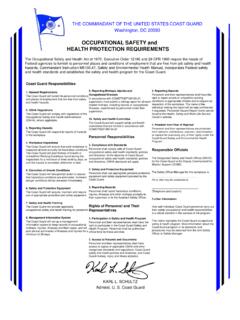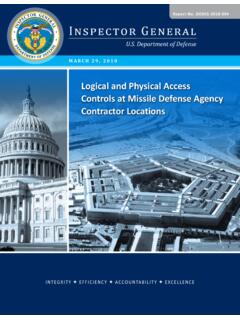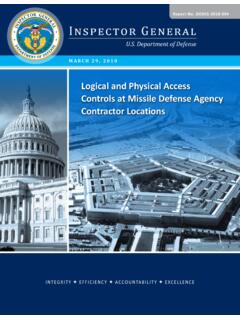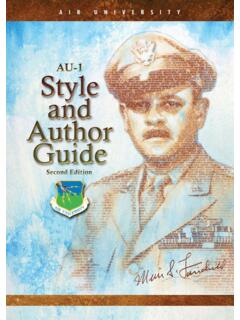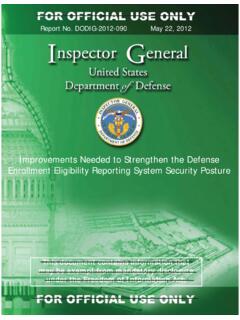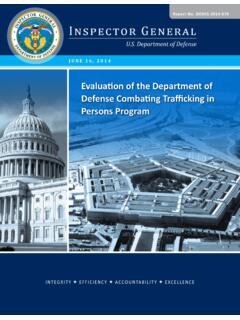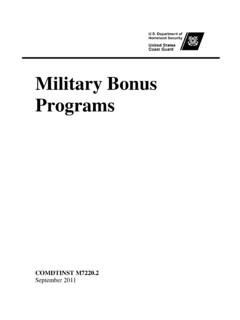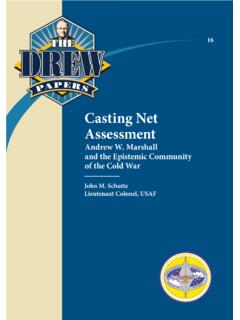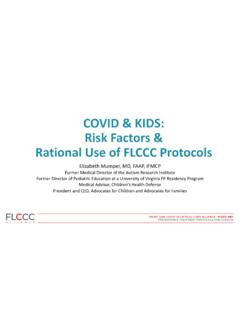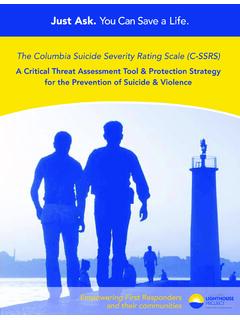Transcription of Ref: (a) OPNAVINST 6100.2A (b) SECNAVINST 6320.24A (c ...
1 DEPARTMENT OF THE NAVY OFFICE OF THE CHIEF OF NAVAL OPERATIONS 2000 NAVY PENTAGON WASHINGTON, DC 20350-2000 OPNAVINST N135 4 Aug 09 OPNAV INSTRUCTION From: Chief of Naval Operations Subj: suicide PREVENTION PROGRAM Ref: (a) OPNAVINST (b) SECNAVINST (c) MILPERSMAN 1770 (d) OPNAVINST (NOTAL) Encl: (1) suicide Risk Factors, Protective Factors, and Resources (2) Definitions of suicide Related Behaviors (3) Sample Command suicide Prevention/Crisis Response Plan Checklist 1. Purpose. To provide policy, procedures and assign responsibilities for the Navy s suicide Prevention Program per references (a) through (d).
2 2. Cancellation. OPNAVINST 3. Applicability. Provisions of this instruction apply to all Active and Reserve Navy units within the Department of the Navy (DON). 4. Background a. suicide is a preventable personnel loss that impacts unit readiness, morale and mission effectiveness. Relationship disruption, substance abuse, financial problems, legal problems, and mental health problems (such as depression) can interfere with individual efficiency and unit effectiveness and also increase a person s suicide risk. Factors including positive attitude, solid spirituality, good problem solving skills, and healthy stress control can increase individual efficiency and unit effectiveness and reduce risk of intentional self harm.
3 As such, preventing suicide in the Navy begins with promotion of health and wellness consistent with keeping Service members OPNAVINST 4 Aug 09 2 ready to accomplish the mission. Enclosure (1) contains a list of suicide risk factors, protective factors and resources for assistance. b. Navy suicide prevention programs consist of four elements: (1) Training increasing awareness of suicide concerns, improving wellness and ensuring personnel know how to intervene when someone needs help. (2) Intervention ensuring timely access to needed services and having a plan of action for crisis response. (3) Response assisting families, units and Service members affected by suicide behaviors. (4) Reporting reporting incidents of suicide and suicide -related behaviors (procedures outlined in subparagraph 5d below).
4 C. Medical personnel, chaplains, Fleet and Family Support Center (FFSC) counselors, health promotion program leaders, the Navy Reserve Psychological Health Outreach team, substance-abuse counselors, and command suicide Prevention Coordinators (SPCs) support local leaders with information in their areas of expertise, intervention services, and assistance in crisis management. d. Terms used in this instruction are included in enclosure (2). 5. Policy. Command suicide prevention programs, consistent with reference (a), shall be implemented to reduce the risk of suicide , to minimize adverse effects of suicidal behavior on command readiness and morale, and to preserve mission effectiveness and war-fighting capability.
5 suicide prevention programs shall include the following: a. Training (1) suicide prevention training shall be conducted at least annually for all Active Component (AC) and Reserve Component (RC) Service members and for all Navy civilian OPNAVINST 4 Aug 09 3employees and full-time contractors who work on military installations. General Military Training (GMT) materials may fulfill part of this training requirement but must be supplemented with information on local action plans and support resources. suicide prevention training should include, but is not limited to: (a) Everyone s duty to obtain assistance for others in the event of suicidal threats or behaviors; (b) Recognition of specific risk factors for suicide ; (c) Identification of signs and symptoms of mental health concerns and operational stress; (d) Protocols for responding to crisis situations involving those who may be at high risk for suicide ; and (e) Contact information for local support services.
6 (2) Life-skills/health promotions training, such as alcohol abuse avoidance, parenting skills and skills for managing finances, stress, conflict and relationships will be provided to enhance coping skills and reduce the incidence of problems that might detract from personal and unit readiness. (3) Messages will be published to provide suicide prevention information and guidance to all personnel. Emphasis shall be given to promoting the health, welfare and readiness of the Navy community; to providing support for those who seek help for personal problems; and, to ensuring access to care for those who seek help. b. Intervention (1) Commanding Officers (COs) shall have written suicide prevention and crisis intervention plans that include the process for identification, referral, access to treatment and follow-up procedures for personnel who indicate a heightened risk of suicide .
7 OPNAVINST 4 Aug 09 4 (2) COs shall foster a command climate that supports and promotes psychological health consistent with operational stress control principles. For example: (a) Foster unit morale and cohesion; (b) Promote physical fitness; (c) Provide clear direction and sense of mission; (d) Deglamorize alcohol use; (e) Know your Service members; (f) Ensure adequate time for rest; (g) Encourage good communication; (h) Help Service members maintain a work-life balance; (i) Do positive after-action reviews; (j) Reward accomplishments; (k) Refer early for intervention; (l) Communicate/coordinate with mental health providers; and (m) Reintegrate Service member back into the unit after treatment.
8 (3) COs shall provide support for those who seek help with personal problems. Access must be provided to prevention, counseling and treatment programs and services supporting the early resolution of mental health, and family and personal problems that underlie suicidal behavior. (4) If a Service member s comments, written communication or behaviors lead the command to believe there is imminent risk that the person may cause harm to self or others, command leadership must take safety measures that include restricting OPNAVINST 4 Aug 09 5access of at-risk personnel to means that can be used to inflict harm and seek emergent mental health evaluation consistent with reference (b). c. Response. In the event of a suicide or serious suicide -related behavior, families and affected personnel shall be provided support by the command and local mental health resources.
9 Commands shall use organic resources or consult with the nearest medical personnel, chaplains or FFSC counselors to assess requirements for supportive interventions for units and affected Service members and shall coordinate with all local resources to implement interventions when needed. d. Reporting (1) Suicides and suicide -related behaviors shall be reported per references (c) and (d). Definitions for various suicide -related behaviors are provided in enclosure (2). (2) A suicide is a self-inflicted death with evidence (either implicit or explicit) of intent to die. In instances of suicide and undetermined deaths for which suicide has not been excluded by the medical examiner, commands shall complete the Department of Defense suicide Event Report (DoDSER) (available at ) within 60 days of notification of death.
10 Commands are advised to maintain copies of medical, dental and service records for 6 to 8 weeks after the member s death in order to complete the DoDSER and respond to unforeseen questions. (3) A suicide attempt is a self-inflicted potentially injurious behavior with a non-fatal outcome that may or may not result in injury and for which there is evidence (either implicit or explicit) of intent to die. A DoDSER shall be completed for all suicide attempts by AC and RC Service members, as determined by competent medical authority, within 30 days of medical evaluation. suicide attempt DoDSERs shall be completed by the military medical provider at the facility responsible for the member s psychological assessment or (if assessment occurs at a civilian facility) by the Military Treatment Facility (MTF) responsible for the TRICARE referral or by the RC command medical representative (for RC not on active duty).
